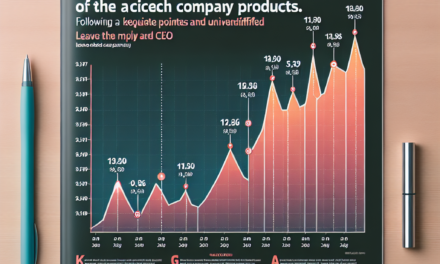“2024/25 Profit Forecast Soars: Holiday Sales Surge Ignites Growth!”
Introduction
The 2024/25 profit forecast has been significantly enhanced due to a remarkable surge in holiday sales, reflecting strong consumer demand and effective marketing strategies. Retailers have reported unprecedented growth during the holiday season, driven by a combination of innovative promotions, expanded online shopping options, and a resurgence in in-store traffic. This positive trend not only indicates a robust economic recovery but also positions companies for sustained profitability in the upcoming fiscal year. As businesses capitalize on this momentum, analysts are optimistic about the potential for continued growth and increased market share in the competitive retail landscape.
Holiday Sales Trends Impacting 2024/25 Profit Forecast
As the holiday season approaches, businesses are keenly observing emerging sales trends that could significantly influence their profit forecasts for the 2024/25 fiscal year. The holiday shopping period, traditionally characterized by increased consumer spending, has shown promising signs of a surge that could bolster overall profitability. This year, several factors are converging to create an environment ripe for robust holiday sales, which in turn, is expected to have a positive impact on profit projections.
One of the most notable trends is the increasing consumer confidence observed in recent months. As economic indicators suggest a steady recovery from previous downturns, consumers are more willing to spend on discretionary items. This renewed optimism is reflected in various surveys indicating that shoppers plan to allocate more of their budgets to holiday purchases compared to previous years. Consequently, businesses are adjusting their strategies to capitalize on this heightened consumer enthusiasm, anticipating that a larger share of wallets will translate into increased sales volumes.
Moreover, the shift towards e-commerce continues to reshape the retail landscape. With online shopping becoming a preferred method for many consumers, businesses are investing heavily in their digital platforms to enhance user experience and streamline the purchasing process. This investment is not merely a response to changing consumer behavior; it is also a proactive measure to capture a larger market share during the holiday season. As a result, companies that effectively leverage their online presence are likely to see significant gains in sales, further contributing to an optimistic profit forecast for the upcoming fiscal year.
In addition to the digital shift, the trend of early holiday shopping is gaining momentum. Many retailers are beginning their holiday promotions earlier than ever, encouraging consumers to start their shopping well before traditional peak periods. This strategy not only helps to spread out sales over a longer timeframe but also mitigates the risks associated with supply chain disruptions that have plagued many industries in recent years. By enticing consumers to shop early, businesses can better manage inventory levels and ensure that they meet demand without overextending their resources. This proactive approach is expected to yield positive results, enhancing profit margins as companies navigate the complexities of the holiday season.
Furthermore, the growing emphasis on sustainability and ethical consumerism is influencing purchasing decisions. Shoppers are increasingly seeking out brands that align with their values, particularly during the holiday season when gift-giving is prevalent. Companies that prioritize sustainable practices and transparent supply chains are likely to attract a loyal customer base, which can lead to increased sales and, ultimately, improved profitability. This trend underscores the importance of aligning business practices with consumer expectations, as those that do so may find themselves well-positioned to capitalize on the holiday sales surge.
As businesses prepare for the upcoming holiday season, it is clear that a combination of consumer confidence, the rise of e-commerce, early shopping trends, and a focus on sustainability will play pivotal roles in shaping profit forecasts for 2024/25. By understanding and adapting to these trends, companies can not only enhance their sales performance during the holiday period but also lay a strong foundation for sustained growth in the future. Ultimately, the ability to navigate these dynamics will determine which businesses thrive in the competitive landscape, making the holiday season a critical time for strategic planning and execution.
Strategies to Maximize Holiday Sales for Increased Profits
As the holiday season approaches, businesses are presented with a unique opportunity to enhance their profitability through strategic planning and execution. The surge in consumer spending during this period can significantly impact profit forecasts, particularly for the 2024/25 fiscal year. To capitalize on this potential, companies must adopt a multifaceted approach that encompasses marketing, inventory management, customer engagement, and operational efficiency.
One of the most effective strategies to maximize holiday sales is to implement targeted marketing campaigns that resonate with the holiday spirit. Businesses should leverage data analytics to identify consumer preferences and tailor their promotions accordingly. By utilizing social media platforms, email marketing, and personalized advertisements, companies can create a sense of urgency and excitement around their products. For instance, limited-time offers and exclusive holiday bundles can entice customers to make purchases, thereby increasing sales volume. Furthermore, engaging storytelling that highlights the emotional aspects of gift-giving can foster a deeper connection with consumers, encouraging them to choose specific brands over competitors.
In addition to marketing efforts, effective inventory management is crucial during the holiday season. Businesses must anticipate demand fluctuations and ensure that they have adequate stock levels to meet customer needs. This requires a careful analysis of historical sales data and current market trends. By employing just-in-time inventory practices, companies can minimize excess stock while still being prepared for peak shopping days. Moreover, utilizing technology such as inventory management software can streamline operations, allowing businesses to track stock levels in real-time and make informed decisions about restocking and order fulfillment.
Customer engagement plays a pivotal role in driving holiday sales. Creating an exceptional shopping experience can lead to increased customer loyalty and repeat business. Companies should focus on enhancing both online and in-store experiences by providing personalized service, easy navigation, and seamless checkout processes. Additionally, implementing loyalty programs that reward customers for their purchases can incentivize them to spend more during the holiday season. By fostering a sense of community and appreciation, businesses can encourage customers to return long after the holidays have passed.
Moreover, operational efficiency is essential for maximizing profits during this busy period. Businesses should evaluate their supply chain processes to identify potential bottlenecks that could hinder timely delivery and customer satisfaction. Streamlining logistics and collaborating with reliable shipping partners can ensure that products reach customers promptly, thereby enhancing the overall shopping experience. Furthermore, training staff to handle increased foot traffic and online orders can improve service quality and reduce wait times, ultimately leading to higher sales.
As the holiday season unfolds, businesses must remain agile and responsive to changing consumer behaviors. Monitoring sales trends and customer feedback in real-time allows companies to adjust their strategies as needed. For instance, if a particular product is experiencing higher-than-expected demand, businesses can quickly pivot their marketing efforts to promote that item further. This adaptability not only maximizes sales potential but also positions companies favorably for the upcoming fiscal year.
In conclusion, the holiday season presents a significant opportunity for businesses to boost their profits through strategic initiatives. By focusing on targeted marketing, effective inventory management, enhanced customer engagement, and operational efficiency, companies can maximize their holiday sales and set a strong foundation for the 2024/25 profit forecast. As consumer spending continues to rise during this festive period, those who implement these strategies will likely reap the rewards of increased profitability and sustained growth.
Analyzing Consumer Behavior During Holiday Seasons
As the holiday season approaches, businesses and analysts alike turn their attention to consumer behavior, which plays a pivotal role in shaping profit forecasts for the upcoming fiscal year. The 2024/25 profit forecast has been notably boosted by an anticipated surge in holiday sales, prompting a closer examination of the factors influencing consumer spending during this critical period. Understanding these dynamics is essential for companies aiming to capitalize on the seasonal shopping frenzy.
Historically, the holiday season has been characterized by increased consumer spending, driven by a combination of cultural traditions, marketing strategies, and economic conditions. This year, several trends are emerging that suggest a robust holiday shopping season. For instance, the rise of e-commerce has transformed the retail landscape, allowing consumers to shop conveniently from their homes. As online shopping continues to gain traction, businesses are investing heavily in digital marketing and user-friendly platforms to attract consumers. This shift not only broadens the reach of retailers but also enhances the overall shopping experience, making it more appealing for consumers to engage in holiday spending.
Moreover, consumer sentiment plays a crucial role in determining spending patterns during the holiday season. Recent surveys indicate a growing sense of optimism among consumers, fueled by a recovering economy and rising disposable incomes. As individuals feel more secure in their financial situations, they are more likely to indulge in holiday shopping, purchasing gifts for loved ones and treating themselves. This positive sentiment is further amplified by the prevalence of promotional events, such as Black Friday and Cyber Monday, which create a sense of urgency and excitement around holiday shopping. Retailers are leveraging these events to offer significant discounts, enticing consumers to make purchases they might have otherwise postponed.
In addition to economic factors, social influences also shape consumer behavior during the holidays. The desire to connect with family and friends often drives individuals to spend more on gifts and experiences. As people prioritize relationships, they are inclined to invest in meaningful presents that reflect their affection for others. This trend is particularly evident in the growing popularity of personalized gifts, which resonate with consumers seeking to create lasting memories. Furthermore, the influence of social media cannot be overlooked; platforms like Instagram and TikTok have become powerful tools for brands to showcase their products and engage with potential customers. The viral nature of these platforms can lead to increased visibility and, consequently, higher sales during the holiday season.
As we analyze consumer behavior during the holiday seasons, it is essential to consider the impact of sustainability and ethical consumption. A growing number of consumers are becoming more conscious of their purchasing decisions, favoring brands that align with their values. This shift towards sustainable shopping is prompting retailers to adopt eco-friendly practices and promote ethically sourced products. Consequently, businesses that prioritize sustainability may find themselves well-positioned to attract a loyal customer base during the holidays.
In conclusion, the interplay of economic conditions, consumer sentiment, social influences, and ethical considerations creates a complex landscape for holiday shopping. As the 2024/25 profit forecast reflects an optimistic outlook, it is clear that understanding these factors is crucial for businesses aiming to thrive during the holiday season. By adapting to evolving consumer preferences and leveraging innovative marketing strategies, retailers can maximize their potential for success, ultimately contributing to a significant boost in profits as the year unfolds.
The Role of E-Commerce in Holiday Sales Growth
As the holiday season approaches, the role of e-commerce in driving sales growth has become increasingly significant, particularly in the context of the 2024/25 profit forecast. The digital marketplace has transformed the way consumers shop, offering unparalleled convenience and accessibility that traditional retail cannot match. This shift in consumer behavior has been further accelerated by advancements in technology, which have made online shopping more user-friendly and efficient. As a result, businesses are recognizing the necessity of enhancing their e-commerce platforms to capitalize on the holiday sales surge.
One of the primary factors contributing to the growth of e-commerce during the holiday season is the increasing reliance on mobile devices. With smartphones and tablets becoming ubiquitous, consumers are now able to shop anytime and anywhere. This trend has led to a significant rise in mobile commerce, which has proven to be a vital component of holiday sales strategies. Retailers are investing in mobile-optimized websites and applications to ensure a seamless shopping experience, thereby encouraging impulse purchases and increasing overall sales volume.
Moreover, the integration of social media into e-commerce has created new avenues for reaching potential customers. Platforms such as Instagram and Facebook have evolved into powerful marketing tools, allowing businesses to showcase their products and engage with consumers directly. The ability to leverage targeted advertising and influencer partnerships has enabled retailers to create personalized shopping experiences that resonate with their audience. Consequently, this social commerce trend has not only driven traffic to e-commerce sites but has also fostered brand loyalty, which is particularly valuable during the competitive holiday season.
In addition to these technological advancements, the importance of data analytics cannot be overstated. Retailers are increasingly utilizing data-driven insights to understand consumer preferences and shopping behaviors. By analyzing past purchasing patterns and demographic information, businesses can tailor their marketing strategies to meet the specific needs of their target audience. This level of personalization enhances the customer experience, ultimately leading to higher conversion rates and increased sales during the holiday period.
Furthermore, the rise of omnichannel retailing has blurred the lines between online and offline shopping. Many consumers now expect a cohesive shopping experience that allows them to transition seamlessly between different channels. For instance, the option to buy online and pick up in-store has gained popularity, providing customers with the convenience of online shopping while still allowing them to receive their purchases quickly. This strategy not only drives foot traffic to physical locations but also encourages additional purchases, as customers often make unplanned buys while in-store.
As we look ahead to the 2024/25 profit forecast, it is clear that e-commerce will play a pivotal role in shaping holiday sales outcomes. The combination of mobile shopping, social media integration, data analytics, and omnichannel strategies positions retailers to maximize their reach and enhance customer engagement. In this rapidly evolving landscape, businesses that prioritize their e-commerce capabilities are likely to see significant benefits during the holiday season. Ultimately, the ability to adapt to changing consumer preferences and leverage technological advancements will be crucial for retailers aiming to achieve robust sales growth and profitability in the coming years. As the holiday season unfolds, the emphasis on e-commerce will undoubtedly continue to drive the narrative of retail success.
Predictions for Holiday Sales Performance in 2024/25
As the retail sector gears up for the 2024/25 holiday season, analysts are increasingly optimistic about the potential for a significant surge in sales performance. This optimism is largely driven by a combination of factors, including improved consumer confidence, a robust job market, and the ongoing evolution of e-commerce. These elements are expected to converge, creating a favorable environment for retailers to capitalize on holiday shopping trends.
Consumer confidence plays a pivotal role in shaping holiday spending patterns. Recent surveys indicate that consumers are feeling more secure in their financial situations, which is likely to translate into increased discretionary spending during the holiday season. This sentiment is further bolstered by a strong labor market, characterized by low unemployment rates and rising wages. As consumers experience greater financial stability, they are more inclined to indulge in holiday shopping, which bodes well for retailers across various sectors.
Moreover, the rise of e-commerce continues to transform the retail landscape, making it easier for consumers to shop from the comfort of their homes. The convenience of online shopping, coupled with advancements in technology, has led to an increase in the number of consumers who prefer to make purchases digitally. Retailers are responding to this trend by enhancing their online platforms, offering personalized shopping experiences, and implementing efficient logistics solutions to ensure timely delivery. As a result, the 2024/25 holiday season is expected to witness a significant uptick in online sales, contributing to overall revenue growth.
In addition to the shift towards e-commerce, retailers are also adapting their marketing strategies to better engage consumers during the holiday season. Innovative promotional campaigns, including early holiday sales and exclusive online deals, are being employed to attract shoppers. These strategies not only create a sense of urgency but also encourage consumers to start their holiday shopping earlier than in previous years. As a result, retailers are likely to see a more extended shopping period, which can help mitigate the traditional peaks and troughs associated with holiday sales.
Furthermore, the increasing importance of sustainability in consumer purchasing decisions cannot be overlooked. Many shoppers are now prioritizing eco-friendly products and brands that demonstrate a commitment to social responsibility. Retailers that align their offerings with these values are likely to resonate more with consumers, potentially leading to increased sales during the holiday season. This shift towards conscious consumerism is expected to influence purchasing behavior, prompting retailers to highlight sustainable practices in their marketing efforts.
As we look ahead to the 2024/25 holiday season, it is essential to consider the potential impact of external factors, such as inflation and supply chain disruptions. While these challenges could pose risks to sales performance, the overall sentiment remains positive. Retailers are better equipped than ever to navigate these uncertainties, thanks to lessons learned during previous economic fluctuations. By leveraging data analytics and consumer insights, businesses can make informed decisions that enhance their operational efficiency and customer engagement.
In conclusion, the predictions for holiday sales performance in 2024/25 are buoyed by a confluence of favorable factors, including heightened consumer confidence, the continued growth of e-commerce, innovative marketing strategies, and a shift towards sustainability. As retailers prepare for what is anticipated to be a robust holiday season, the focus will be on maximizing opportunities while remaining agile in the face of potential challenges. This proactive approach is likely to yield significant benefits, ultimately boosting profit forecasts and setting the stage for a successful year ahead.
Case Studies of Successful Holiday Sales Campaigns
As businesses prepare for the 2024/25 fiscal year, the impact of holiday sales campaigns on profit forecasts has become increasingly evident. A closer examination of successful holiday sales strategies reveals key elements that contribute to significant revenue boosts during this critical period. By analyzing various case studies, we can identify best practices that not only enhance sales figures but also foster customer loyalty and brand recognition.
One notable example is the holiday campaign launched by a leading e-commerce retailer, which utilized a multi-channel approach to engage customers. By integrating social media, email marketing, and targeted online advertisements, the retailer created a cohesive shopping experience that resonated with consumers. The campaign featured limited-time offers and exclusive discounts, which generated a sense of urgency and encouraged immediate purchases. Furthermore, the retailer leveraged data analytics to personalize marketing messages, ensuring that promotions were tailored to individual customer preferences. This strategic use of technology not only increased conversion rates but also enhanced customer satisfaction, leading to repeat business well beyond the holiday season.
In another instance, a well-known brick-and-mortar store successfully revitalized its holiday sales through an immersive in-store experience. By transforming its retail space into a festive wonderland, the store attracted foot traffic and created a memorable shopping environment. The incorporation of interactive displays and themed events, such as live music and product demonstrations, drew customers in and encouraged them to explore the store. Additionally, the retailer implemented a loyalty program that rewarded customers for their purchases during the holiday season, further incentivizing spending. This case illustrates the importance of creating an engaging atmosphere that not only drives sales but also builds a strong emotional connection with the brand.
Moreover, a prominent fashion brand exemplified the power of influencer partnerships during the holiday season. By collaborating with popular social media influencers, the brand was able to reach a wider audience and tap into the influencers’ established trust with their followers. The campaign featured curated gift guides and styling tips, showcasing the brand’s products in a relatable context. This approach not only increased brand visibility but also encouraged consumers to view the products as desirable gifts for their loved ones. The success of this campaign underscores the effectiveness of leveraging social proof and community engagement to enhance holiday sales.
Additionally, a technology company demonstrated the value of bundling products during the holiday season. By offering special packages that combined popular items at a discounted rate, the company appealed to consumers looking for value during a time of increased spending. This strategy not only boosted sales of individual products but also introduced customers to new offerings they may not have considered otherwise. The bundling approach effectively increased the average transaction value and provided customers with a sense of satisfaction, knowing they were making a smart purchase.
In conclusion, the case studies of successful holiday sales campaigns highlight the diverse strategies that businesses can employ to maximize their profits during this crucial time. From leveraging technology and creating immersive experiences to forming strategic partnerships and offering value through bundling, these examples illustrate that a well-executed holiday campaign can significantly impact a company’s bottom line. As we look ahead to the 2024/25 fiscal year, it is clear that the lessons learned from these successful campaigns will be invaluable for businesses aiming to enhance their holiday sales performance and achieve their profit forecasts.
Preparing Inventory for the Holiday Sales Surge
As the holiday season approaches, businesses are increasingly focused on preparing their inventory to capitalize on the anticipated surge in sales. This period, characterized by heightened consumer spending, presents a unique opportunity for retailers to enhance their profit margins and solidify their market position. To effectively navigate this seasonal influx, companies must adopt a strategic approach to inventory management, ensuring that they are well-equipped to meet customer demand while minimizing excess stock.
One of the first steps in preparing inventory for the holiday sales surge is to analyze historical sales data. By examining trends from previous years, businesses can identify patterns in consumer behavior, such as peak shopping days and popular product categories. This analysis not only aids in forecasting demand but also helps in determining which items should be prioritized in inventory replenishment. For instance, if a particular product consistently sells well during the holiday season, it would be prudent to increase stock levels accordingly. This data-driven approach allows retailers to make informed decisions, reducing the risk of stockouts and lost sales opportunities.
In addition to historical data, businesses should also consider current market trends and consumer preferences. The rise of e-commerce and the growing importance of sustainability are reshaping the retail landscape. As consumers become more environmentally conscious, they are increasingly seeking products that align with their values. Therefore, incorporating eco-friendly items into the inventory mix can not only attract a broader customer base but also enhance brand loyalty. By staying attuned to these trends, retailers can ensure that their inventory reflects the evolving demands of the market, ultimately driving sales during the holiday season.
Moreover, effective communication with suppliers is crucial in preparing for the holiday sales surge. As demand increases, so does the pressure on supply chains. Retailers must engage in proactive discussions with their suppliers to secure timely deliveries and avoid potential bottlenecks. Establishing strong relationships with suppliers can lead to more favorable terms and increased flexibility, allowing businesses to respond swiftly to changing market conditions. By fostering collaboration, retailers can enhance their ability to maintain optimal inventory levels throughout the holiday season.
Another important aspect of inventory preparation is the implementation of robust inventory management systems. These systems enable businesses to track stock levels in real-time, providing valuable insights into inventory turnover and sales performance. By leveraging technology, retailers can streamline their operations, ensuring that they have the right products available at the right time. Additionally, advanced analytics can help identify slow-moving items, allowing businesses to make informed decisions about markdowns or promotions to clear excess stock before the holiday rush.
Finally, it is essential for retailers to develop a comprehensive marketing strategy that aligns with their inventory preparation efforts. Effective marketing campaigns can create buzz around specific products, driving consumer interest and encouraging purchases. By promoting best-selling items and highlighting new arrivals, businesses can maximize their sales potential during the holiday season. Furthermore, integrating online and offline marketing efforts can enhance visibility and reach, ensuring that customers are aware of the products available to them.
In conclusion, preparing inventory for the holiday sales surge requires a multifaceted approach that combines data analysis, supplier collaboration, technology, and strategic marketing. By taking these steps, businesses can position themselves for success, ultimately boosting their profit forecasts for the 2024/25 fiscal year. As the holiday season approaches, those who invest time and resources into effective inventory management will be well-prepared to meet the demands of eager consumers, paving the way for a prosperous season ahead.
Q&A
1. **Question:** What factors contributed to the boosted profit forecast for 2024/25?
**Answer:** The boosted profit forecast is primarily due to a surge in holiday sales, increased consumer spending, and effective marketing strategies.
2. **Question:** How much is the profit forecast expected to increase for 2024/25?
**Answer:** The profit forecast is expected to increase by 15% compared to previous estimates.
3. **Question:** Which sectors are anticipated to benefit the most from the holiday sales surge?
**Answer:** Retail, e-commerce, and consumer electronics sectors are expected to benefit the most.
4. **Question:** What role did online shopping play in the holiday sales surge?
**Answer:** Online shopping significantly contributed to the surge, with a reported increase of 25% in e-commerce sales during the holiday season.
5. **Question:** Are there any specific products that drove the holiday sales surge?
**Answer:** Yes, electronics, home goods, and fashion items were among the top-selling products during the holiday season.
6. **Question:** How are companies preparing for the anticipated increase in demand?
**Answer:** Companies are ramping up inventory, enhancing supply chain logistics, and implementing targeted marketing campaigns.
7. **Question:** What is the expected impact of the holiday sales surge on overall economic growth?
**Answer:** The holiday sales surge is expected to positively impact overall economic growth, contributing to a projected GDP increase of 2% for the year.
Conclusion
The 2024/25 profit forecast has been significantly boosted by a surge in holiday sales, indicating strong consumer demand and effective marketing strategies. This positive trend suggests that businesses are well-positioned to capitalize on seasonal spending, leading to enhanced revenue projections and overall financial performance for the year.





